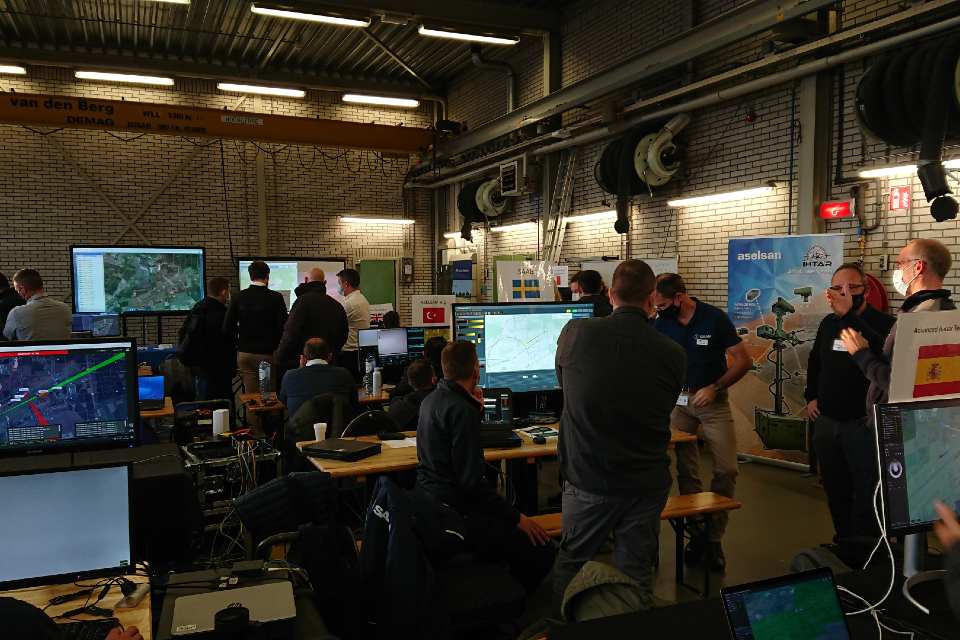Defence Science Technology Laboratory

Sensing for Asset Protection with Integrated Electronic Networked Technology (SAPIENT) uses autonomy to reduce the workload of people operating multi-sensor systems, in security and defence scenarios.
It is the concept of a network of advanced sensors with artificial intelligence (AI) at the edge, combined with intelligent fusion and sensor management.
The benefits of SAPIENT include:
- significantly lower cognitive burden on operators
- lower communications bandwidth
- operational flexibility
- dual defence and security use
- lower acquisition cost
SAPIENT has been adopted by MOD as the standard for counter-UAS (uncrewed air system) technology. It is also being evaluated as a potential NATO standard for counter-drone systems.
Use the SAPIENT standard
The SAPIENTarchitecture is owned byMOD, but theinterface control document (ICD) is freely available as British Standards Institute (BSI) Flex 335, to encourage suppliers and partners to adopt the standard, contribute towards its development, and exploit the technologies created under this initiative.
- Access BSI Flex 335
- Download proto files and other implementation tools and documentation from GitHub

Limitations of current systems
Most security and situational awareness systems, such as CCTV cameras or drone detection systems, simply collect data from their sensors and feed it raw to an operator who assesses the situation and directs the system accordingly. Monitoring and interpreting lots of data requires high communications bandwidth and places a high cognitive burden on the operator.
How SAPIENT works
In the SAPIENT system, the individual sensors are advanced, using artificial intelligence (AI) to make detections and classifications locally, sending only the information not the raw data, to the command and control system. They also make operating decisions autonomously, such as which direction to look or whether to zoom in, in order to fulfil higher-level objectives. These higher-level objectives are managed by a decision-making module which controls the overall system and makes some of the decisions normally made by the operators. This reduces the operators need to constantly monitor the output of the sensors.
Encouraging system integration and development of compatible modules
SAPIENT is a MOD-owned, open-architecture that specifies the standards and protocols that allow modern AI algorithms to work in concert across a suite of sensors. These algorithms reside both on-board the sensor nodes - embodying AI at the edge - and at decision-making nodes. The architecture strongly encourages component modularity (the ability to plug-and-play these modules) which reduces system integration time and creates a competitive supplier ecosystem for the components.
Critically, SAPIENT is designed to enable multi-sensor fusion (correlation, association and tracking) and sensor management (dynamic tasking of the sensors in response to the unfolding scenario). This gives MOD access to the advanced AI solutions that are being developed by our innovative supplier base.
While the key outputs from the SAPIENT initiative are the standards (that is: the ICD) to enable innovative suppliers to develop sensor and decision-making node components, the SAPIENT project has also developed research versions of these components to demonstrate the concept and evaluate the benefits to users.
SAPIENT in action
SAPIENT has been used in a number of high profile international exercises and experiments, leading to wider adoption by industry and partners.
In November 2021 SAPIENTs ICD was evaluated as an interoperability standard for multi-sensor counter-UAS systems, at the NATO technical interoperability exercise (TIE21) in The Netherlands. It was highly successful in facilitating over 70 connections between C-UAS sensor systems and Command and Control (C2) systems. It was further evaluated at TIE22 in September 2022, where it enabled 31 advanced autonomous sensor nodes from different vendors to connect to 13 decision-making nodes.

In September and October 2021 SAPIENT standards, decision-making nodes and compatible sensors were used in the Contested Urban Environment 2021 (CUE2021) exercise. This multinational experiment involved over 60 innovative technologies, many of which were developed as SAPIENT compliant and shared their data using the SAPIENT ICD. Multi-sensor fusion and sensor management was provided by the advanced AI in the SAPIENT decision-making node. This illustrated SAPIENTs critical place in a scalable, layered intelligence, surveillance and reconnaissance (ISR) capability of the future, delivering enhanced situational awareness to support command and control of operations in complex terrain and more efficient employment of ISR assets.
CUE2021 followed on directly after a NATO Science and Technology Organization trial investigating architectures for Interoperability and Networking of Disparate Sensors and Platforms for ISR Applications. Here
